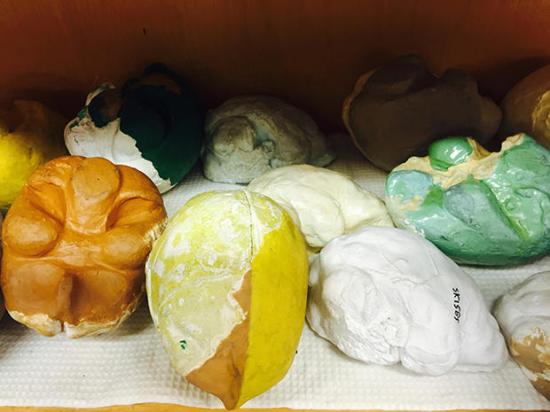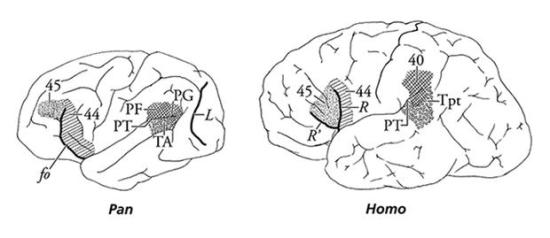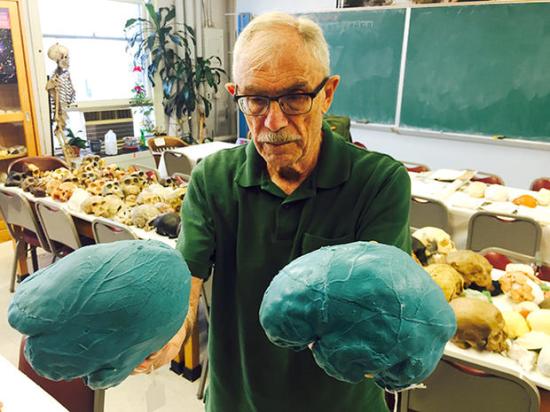PART.2
WHAT HAVE ENDOCASTS TAUGHT US ABOUT THE HUMAN BRAIN?
The record of hominids begins about 6–7 million years ago. From the limited fossils we have, their brains appear to be ape-sized. Based on the scant few fossils from the next few million years, the brain seems to have plateaued in size until roughly 3.5 million years ago, around the time of the hominid genus Australopithecus, which includes the famous Lucy.
The fossil record gets much better around that time, Falk says. That’s how we know that after the long plateau, our brains began to grow—and they kept on growing for the next 3.5 million years, right on up through the Neanderthals—and then to us. (Our brains are smaller than Neanderthals' were.)
 Early hominid endocasts in the Columbia University collection. Image credit: Jen Pinkowski
Early hominid endocasts in the Columbia University collection. Image credit: Jen Pinkowski
When you plot cranial capacity over time, the average brain size of living people is three to four times the size of Australopithecines like Lucy. Her brain was about the size of a large chimp’s (400–450 cubic cms, or ccs). By 2 million years ago, the hominid brain expands to 600–750 ccs, and by the time of Homo erectus, about 1.5 million years ago, brain size increased to 1000 ccs. Today our brains are roughly 1350 ccs.
Interestingly, that’s where the plotline of brain growth levels out. We seem to have plateaued in brain size once again, Falk says. “I suspect that has to do with the obstetrical limitations on the babies than we can bear. They just can't get bigger headed and have mother and child survive. I think that has capped the size of the brain.”
In fact, the modern brain appears to have shrunk by about 10 percent in the past 30,000 years.
But while many scientists view absolute brain size as the best measure for tracking the evolution of cognition in our early ancestors, as Falk writes in Frontiers in Human Neuroscience, size is not everything. The neurological organization of the brain is incredibly important too.
That’s where endocasts have also proven enlightening. Thought they can’t reveal the interior of the brain, they can reveal the brain's overall shape and size, and, crucially, the surface of the cerebral cortex. That’s important because the cerebral cortex is “where we do our highest thinking,” Falk says. Conscious thought, rational problem solving, planning, language, social skills, and scientific, artistic, and musical creativity are all facilitated by the cerebral cortex.
Paleoneurologists analyze features and patterns on the surface of the brain, which is covered in convolutions of gray matter called gyri that are separated by grooves called sulci. These patterns of sulci can reveal details about the organization of a specific brain at a point in time.
 Typical sulcal patterns on the brains of chimpanzees and humans. Image credit: Dean Falk
Typical sulcal patterns on the brains of chimpanzees and humans. Image credit: Dean Falk
What they’ve found by looking at changes to the surface over time is that throughout our evolutionary history, once our brains got bigger, they reorganized too. While we're not sure whether changes in brain size and organization happened simultaneously, they've largely occurred in association over the past few million years.
When our hominid ancestors' brain changed, their behavior changed too. For instance, about 3 million years ago, the Australopithecus primary visual cortex gets smaller, and the parietal lobe expands; we can spot this on endocasts. Meanwhile, these creatures were walking upright. The reverse is likely also true: As behavior changed, the brain altered too.
When the hominid brain leaped in size about 2 million years ago, asymmetries developed, most notably in Broca’s area, a region on the left side of frontal lobe associated with language processing. “It has a very particular configuration,” Falk says. “In humans you've got a particular repeatable pattern of convolutions that you don't see in apes. That's a huge change.” Such asymmetries are characteristic of the modern human brain.
Another change, she says, appeared in the frontal lobe, in the prefrontal cortex. Neuroscientists have shown that one region, called Brodmann area 10, is greatly enlarged in humans compared to primates, and that the difference developed early on in our evolutionary history, perhaps 6 or 7 million years ago. This enlargement seems to have been related to the expansion of the prefrontal association cortices, which are parts of the brain that integrate information from other regions that are more specialized.
"What these changes have in common is that they're all related to the expansion of the association cortices," Falk says. "That's what makes humans humans: We have these brains with these networks where we can really integrate and compute information from multiple senses, including internal stimulation—just thinking on our own, for no reason at all."
CAN ENDOCASTS TEACH US ANYTHING ABOUT OUR BRAINS TODAY?
 Holloway holds endocasts of two modern human heads: one from a person in Peru whose skull in life had been intentionally wrapped and sculpted; and the other of a more typical modern human. Reproductions of hominid skulls span the table behind him. Image credit: Jen Pinkowski
Holloway holds endocasts of two modern human heads: one from a person in Peru whose skull in life had been intentionally wrapped and sculpted; and the other of a more typical modern human. Reproductions of hominid skulls span the table behind him. Image credit: Jen Pinkowski
Perhaps. How did human brains get to be this way? How did we get to be this way? There are many theories. One old dominant theory gives credit to “Man the Hunter"; in this theory, the need to coordinate for the hunt gave rise to both speech and social cooperation. You may have also heard of "Woman the Gatherer," who is said to have been the catalyst for these same characteristics by cooperating with others, often multigenerationally, to gather food—the most reliable source of nutrition—and care for the young.
Falk argues for a third: Baby the Trendsetter. She posits that caring for our increasingly large brained, helpless young sparked a host of important evolutionary changes. One especially key development was the selection for language—witnessed in endocasts, for example, with the change in Broca's area—which Falk argues is the primary driver of our essential humanness. And we may have to thank babies for that. When we became bipedal, we lost the gripping toe that allows primate babies to hold onto their mothers as they go about their business. According to Falk's "putting the baby down" theory, to free up their hands, our upright early ancestors had to put the baby down to get things done.
Because they crave constant contact, babies don't like to be put down. To soothe them—a squalling, distressed young hominid was sure to attract opportunistic predators—Hominid mothers made vocalizations to their young. Today we call the seemingly universal tendency to coo at babies in a singsong tone "Motherese." Hominid proto-Motherese, Falk argues, was essential to the development of language. Hers is one of many ideas about how we developed this singular human characteristic.
The Baby the Trendsetter idea is the anchor for another theory Falk has, based on the idea that the evolutionary trends can be used to illuminate the modern brain. Specifically, she's looking at Asperger's syndrome from an evolutionary perspective.
Technically, Asperger's—a developmental disorder marked by high intelligence, low social skills, language facility, eccentric behavior, and obsessive tendencies—no longer exists; in 2013, it was folded into autism spectrum disorder, a new classification in the American Psychiatric Association's Diagnostic and Statistical Manual of Mental Disorders, or DSM-5. But Falk maintains that Asperger's is real; is not autism—not even high-functioning autism; and reflects a unique twist on the evolution of the human brain.
"I ask whether we should consider it pathological, or whether one should think of it in terms of natural human variation," Falk says.
She identifies three key trends in human evolutionary development that transformed the course of hominin neurological and cognitive evolution: a delay in locomotor development; the tendency to seek comfort from physical contact; and accelerated early brain growth. People with Asperger's, she says, express these three trends in a different way.
As for the first two trends, "Aspies" can be uncoordinated and clumsy, and their problems with social interactions are well known. And then there's the accelerated brain growth. The extraordinary spurt of brain growth that starts prenatally and continues through the first year is unique to humans among primates. "This was important in human evolution as human brain size increased over time," Falk says.
People with Asperger's have a first-year brain spurt that's on the extreme high end of the range of variation. "This is an advanced derived feature in human evolution," she says. This could be related to their tendency to be highly intelligent, especially in the computational and analytical realms. Falk is currently co-authoring a book on the topic with her 24-year-old granddaughter, who has Asperger's.
What does this have to do with endocasts? A few things. For one, there's still a lot we don't know about the brains of our early human ancestors, but we know a lot more than we used to, thanks to this somewhat old-school technique. For another, there's a lot we don't know about modern brains either. Falk's research into Asperger's is just one project out there among many attempting to connect the two. It's likely to be controversial. But that's fitting, in a way. What Falk, Holloway, and other paleoneurologists have documented with endocasts is physical evidence of some of the advanced cognitive characteristics that make us so different from our primate relatives—and from our own earliest ancestors. Debating the details, their larger importance, and whether they have any application to life today—well, that's essentially human too.